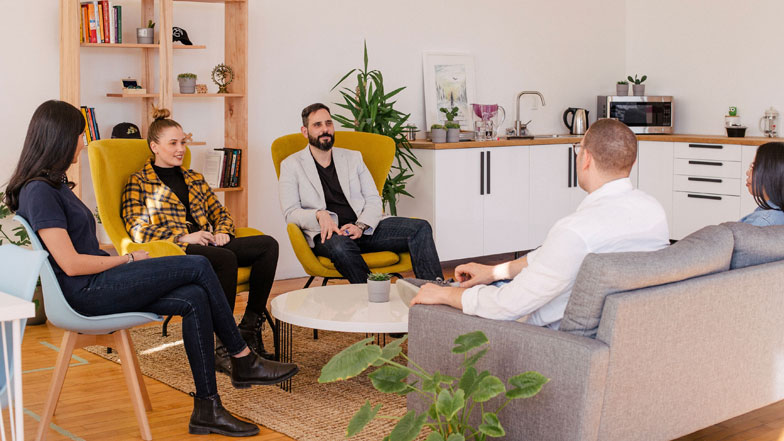
It can take anywhere between five and 30 seconds for a person to form an opinion of you…
First impressions are not only vital to the success of your interview, they’re also nearly impossible to change. And whilst preparing for common interview questions is a key part of nailing the interview, your body language might be saying more than your answers.
To make sure you don’t end your interview before it’s even begun, here’s our guide to the do’s and don’ts of interview body language:
Body language: interview dos:
- Walk in confidently– It’s important you look as professional as possible from the outset. As soon as you walk into the building you’ll begin to be judged on your behaviour. There are even instances where recruiters watch from their office as candidates arrive, to see how their body language changes.
- Deliver a firm handshake – Come on too weak and you’ll seem submissive, but come on too strong and you could be seen to be trying too hard. Keep it firm, but try not to crush their fingers. Finally, to avoid awkward situations, always remember to let go.
- Sit up straight– Avoid being too stiff, but try to sit up straight, keeping the small of your back against the chair. Keep your legs straight and as still as possible. It’s OK to lean forward slightly every so often, as it shows the interviewer that you’re listening, but don’t overdo it.
- Keep eye contact – Maintaining eye contact shows the interviewer you’re not intimidated, and that you’re taking everything in. If you feel uncomfortable, look away for a few seconds or try looking at their nose. Around 10 seconds of good eye contact at a time is a good guideline.
- Smile– Recruiters seldom employ miserable people. It’s OK to be nervous, but something as simple as a smile will make you look more relaxed, comfortable and personable. To put it simply, it will make you more likeable.
- Watch your hands– It’s fine to be animated and gesticulate with your hands to make a point, but don’t go overboard. Keep your arms uncrossed and your hands away from your face (touching your nose or ear is sometimes said to indicate lying). If you’re worried about keeping still, ask if you can take notes. It makes you look like you’re paying attention, and also keeps your hands busy.
Other things to do: turn your phone off, keep your head up, keep your feet still.
How to: deal with stress in an interview
Body language: interview don’ts:
- Be overconfident– Arrogance is not a good look. Walking into an interview thinking that you’ve already got the job can be detrimental. Remember: arrogance and confidence is not the same thing.
- Offer a weak handshake – A weak handshake not only indicates a lack of confidence, it can also be very awkward. Try and mirror your interviewer’s handshake, and apply the same amount of pressure. Seems obvious, but you’d be surprised how many people get this wrong. N.B. It is never acceptable to fist-bump an interviewer – explosion or no explosion.
- Slouch– Bad posture can make you look bored and uninterested. The same goes for crossing your arms and legs. Ok, so you might just be cold, but this can often be seen negatively. Effectively, you are closing yourself off from the situation.
- Stare – It’s always important to maintain eye contact, but there’s definitely a limit. Don’t make it too intense. There’s a fine line between being attentive and being frightening. Finally, always remember to blink.
- Play with your pen/hair – Really think about this one. It seems so obvious, but as with most body language, you often don’t know you’re doing it. Be aware of any bad habits you have before your interview, and keep them in the back of your mind. If you’re not aware of any, try asking a few (good) friends. Just try not to take it personally…
- Fidget – Try to avoid moving around too much. Nervously moving your feet or constantly changing position will only make you look awkward and uncomfortable. Whilst it’s important not to look too wooden, fidgeting can be just as bad.
Other things not to do: chew gum, keep your hands in your pockets, zone out, tap your finger, tap your pen, go in for a hug.
Eight of the most awkward interview moments
12 things you should never do at an interview
Interview body language: What not to do
Final thoughts
OK, so we know that none of these points are particularly new or innovative. However, they still need to be considered.
The old adage that ‘actions speak louder than words’ may seem cliché, but when more than 60% of first impressions are formed by body language, it should definitely be a key part of your interview preparation.
This doesn’t mean you need to practice in front of the mirror, but keeping the above do’s and don’ts in mind before and during your interview will definitely improve the way you present yourself. After all, you might be committing a number of the above body language faux-pas, without even realising it.
The prospective employer already thinks you can do the job on paper. Now’s your chance to show them you can do it person.
How to: Prepare for an interview
How to: Deal with interview rejection
Still searching for your perfect position? View all available jobs now






As a Muslim we don’t shake. It’s something to bear in mind when you are interviewing with people from the Middle East. Unless they offer their hand do not offer to shake because culturally women can not shake men’s hands . I’m sure a lot of other readers will have their opinions but as a former recruiter in the Middle East I think I have a clear understanding of this.